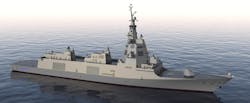Lockheed Martin has made major investments in the development of solid-state S-band radar and will be working with Spain’s national shipbuilder, Navantia, on equipping five F-110 frigates with the tactical long-range discrimination radar (LRDR). The contract with Navantia covers radar design and test services at a land-based test site at Centro de Integracion de Sistemas en Tierra (CIST).
Developed as part of a large contract awarded in 2015, the S-band radar system was designed to provide target discrimination capability for the U.S. DoD Ballistic Missile Defense System (BMDS) and to arm allied systems as part of their integration of Aegis electronic defense systems. Designated recently by the DoD as the AN/SPY-7(V)1 radar, this digital, solid-state version of the radar is a modular, scalable version of the system that can be readily modified and upgraded according to modernization requirements.
Lockheed Martin will work with shipbuilder Navantia to integrate the long-range radar systems onboard the multiple-mission F-110 frigates. Although the first of the frigates is not expected to be deployed until 2026, integration of the solid-state radar system will enable the frigates to perform new missions around the world, with the modular flexibility for interoperability with other navies around the world. The frigates will be the first vessels in the Spanish Navy equipped with the solid-state S-band radars. The radar systems will be supplied jointly by Spanish company Indra and Lockheed Martin, which has been working with Spanish partners on the development and production of tactical naval radar systems for more than 20 years.

